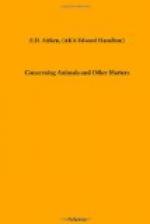Look at a peacock. Its train, by the way, is a false tail, like the chignon of twenty years ago, or the fringe of the present day; the true tail is under it, and serves no purpose but to support it. Now the peacock lives on the ground, among scrub and brushwood, haunted by jackals and wild cats. They, like soldiers in khaki, reconnoitre him in a uniform expressly designed to elude the eye, but he flaunts a flag resplendent with green and gold. And when his one chance of life lies in springing nimbly from the ground and committing himself to his strong wings, he must lift and carry this ponderous paraphernalia with him. And the terrible Bonelli’s eagle is soaring above. But all is risked proudly for the sake of the morning hour in the glade where the ladies assemble. And the peacock is only one of many. Not to mention the lyre bird, the Argus pheasant, the bird of paradise, and other splendid examples, there are common dicky-birds which point the moral and adorn the tail as emphatically.
If the tail is a rudder, where should you look to find it in its most simple and efficient form but among the flycatchers, which make their living by aerial acrobatics after flies? Yet this family seems to be peculiarly prone to the vanity of a stylish tail. The paradise flycatcher flutters two streamers a foot long, like white ribbons, behind it. The fantail could hide behind its own fan. The bee-eater has the two central feathers prolonged and pointed. The drongos, which are flycatchers in habit, wear their tails very long and deeply forked; and one of them, the racket-tailed drongo, has the two side feathers extended beyond the rest for nearly a foot, and as thin as wires, expanding into a blade at the ends. I have seen nothing in ladies’ hats more preposterous. It is vain to object that there can be no proper comparison between tails and hats because the woman chooses her own hat while the bird has to wear what Nature has given it. I know that, but the contention is utterly superficial. What choice has a woman as to the style of her hat? Fashion prescribes for




